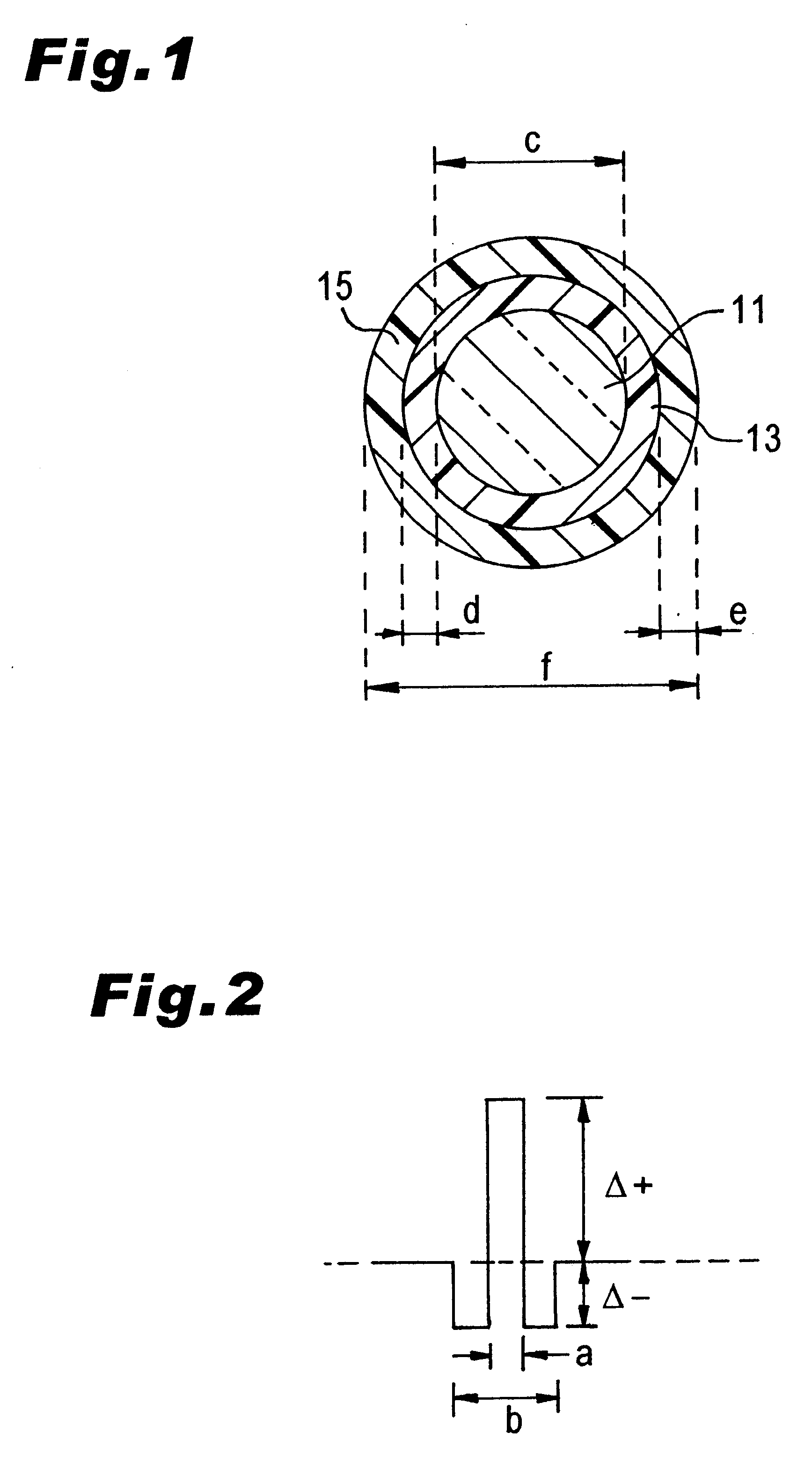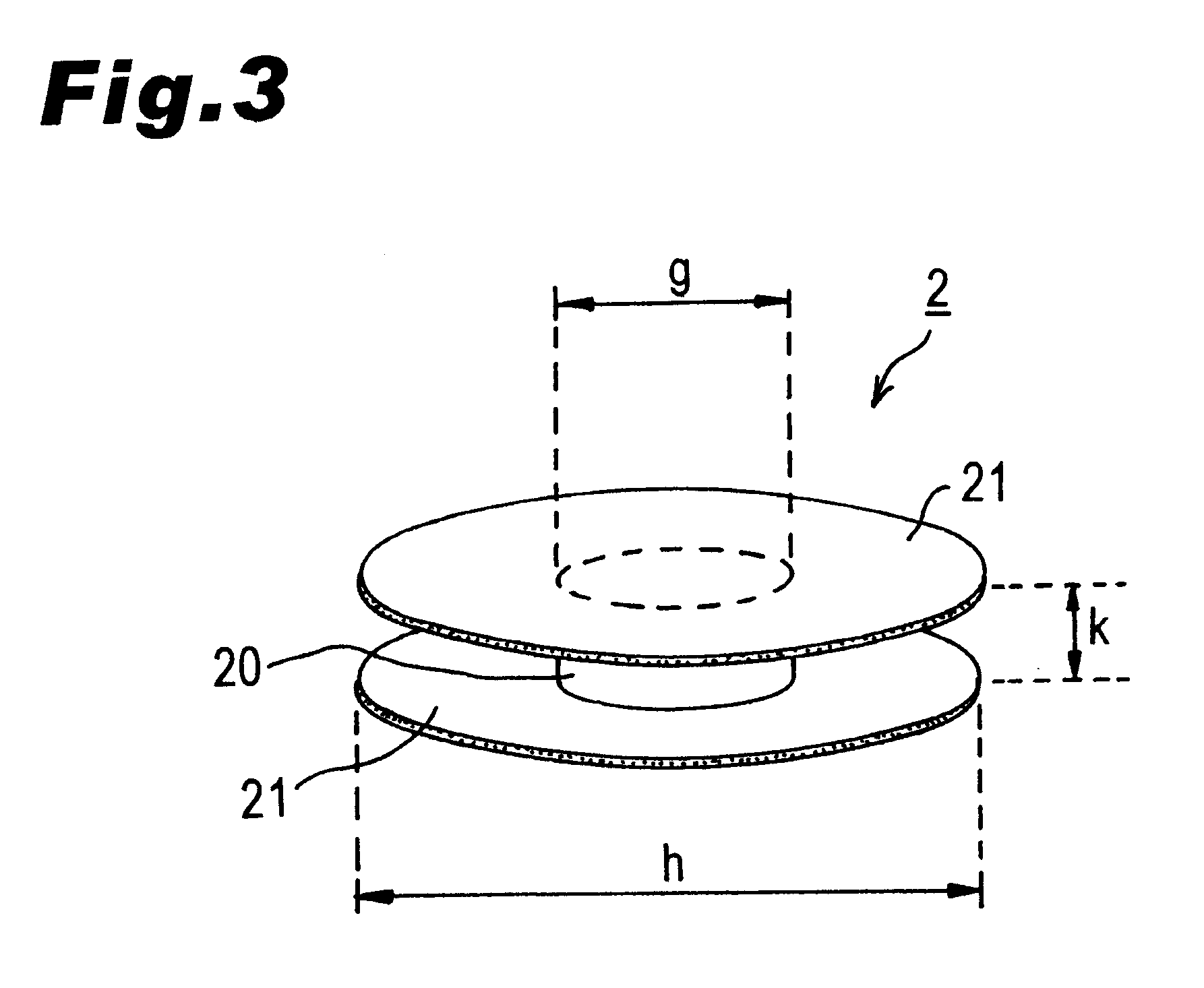Coiled optical assembly and fabricating method for the same
a technology of optical assembly and coiled ends, which is applied in the direction of clad optical fiber, glass optical fibre, instruments, etc., can solve the problems of deteriorating signal quality, large wavelength dispersion, and optical signal distortion
- Summary
- Abstract
- Description
- Claims
- Application Information
AI Technical Summary
Problems solved by technology
Method used
Image
Examples
example b
Around a bobbin 2 made of aluminum in which g=60 mm and k=45 mm, about 190 plies of a DCF, identical to that of Example A, having a length of 13 km were wound with a winding pitch of 0.28 mm at each of three kinds of take-up tensions of 20 gf, 25 gf, and 50 gf, whereby three kinds of dispersion compensators were produced.
FIG. 26 is a graph plotting thus obtained three kinds of dispersion compensators in terms of take-up tension and transmission loss value at a wavelength of 1.55 .mu.m which are indicated by the abscissa and the ordinate, respectively. The broken line is a transmission loss value shown for comparison as with FIG. 25. The transmission value was 2.54 dB / km and 1.05 dB / km when the take-up tension was 50 gf and 25 gf, respectively, thereby becoming smaller as the take-up tension was lower. At the take-up tension of 20 gf, however, the transmission loss value increased to 2.95 dB / km. It is assumed to be because the take-up tension was so low that the winding of the fiber ...
example c
Around a bobbin 2 made of aluminum in which g=100 mm and k=18 mm, about 210 plies of a DCF having a length of 8 km and the characteristics shown in the following Table (see FIGS. 1 and 2 for its form and refractive index profile, respectively) were wound with a winding pitch of 0.40 mm at each of four kinds of take-up tensions of 20 gf, 30 gf, 40 gf, and 50 gf, whereby four kinds of dispersion compensators were produced. This DCF has the specific characteristics shown in the following Table.
FIG. 27 is a graph plotting thus obtained four kinds of dispersion compensators in terms of take-up tension and transmission loss value at a wavelength of 1.55 .mu.m which are indicated by the abscissa and the ordinate, respectively. The broken line also indicates take-up tension and transmission loss value by the abscissa and the ordinate, respectively. The broken line indicates the transmission loss value (0.45 dB / km) at a wavelength of 1.55 .mu.m before the coil is taken up. The transmission l...
example d
Around a bobbin 2 made of aluminum in which g=80 mm and k=45 mm, about 190 plies of a DCF having a length of 14 km and the characteristics shown in the following Table (see FIGS. 1 and 2 for its form and refractive index profile, respectively) were wound at a take-up tension of 35 gf with each of four kinds of winding pitches of 0.2 mm, 0.4 mm, 0.6 mm, and 1.0 mm, whereby four kinds of dispersion compensators were produced. This DCF has the specific characteristics shown in the following Table.
FIG. 28 is a graph plotting thus obtained four kinds of dispersion compensators (with black circles) in terms of winding pitch and PMD which are indicated by the abscissa and the ordinate, respectively. While PMD was 1.68 ps when the winding pitch was 0.2 mm, it became 1.12 ps, 0.94 ps, and 0.90 ps at the winding pitches of 0.4 mm, 0.6 mm, and 1.0 mm, respectively. Hence, it has been confirmed that PMD can be lowered when the winding pitch is made greater as compared with the diameter of the D...
PUM
 Login to View More
Login to View More Abstract
Description
Claims
Application Information
 Login to View More
Login to View More - R&D
- Intellectual Property
- Life Sciences
- Materials
- Tech Scout
- Unparalleled Data Quality
- Higher Quality Content
- 60% Fewer Hallucinations
Browse by: Latest US Patents, China's latest patents, Technical Efficacy Thesaurus, Application Domain, Technology Topic, Popular Technical Reports.
© 2025 PatSnap. All rights reserved.Legal|Privacy policy|Modern Slavery Act Transparency Statement|Sitemap|About US| Contact US: help@patsnap.com



